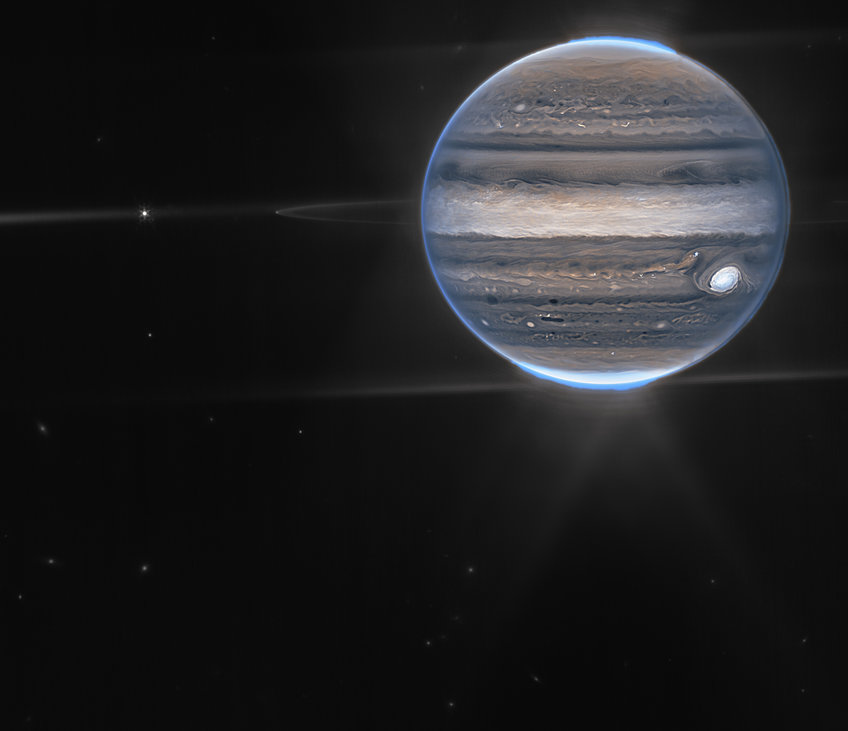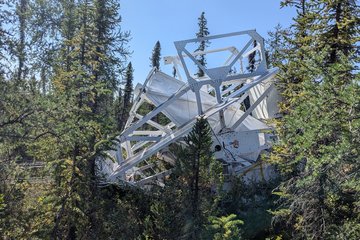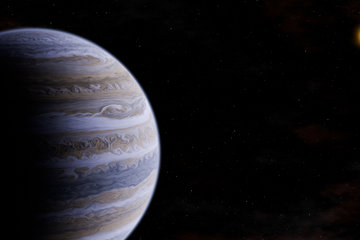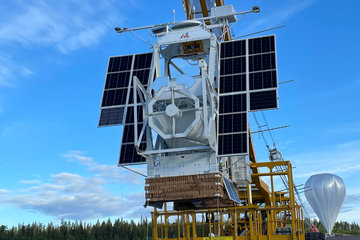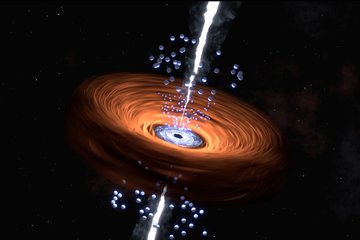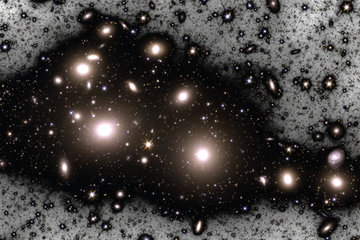Giant Auroras Modify Jupiter’s Stratospheric Chemistry
A collision nearly 30 years ago permanently changed Jupiter's atmospheric chemistry; the aftermath is still helping to better understand the gas giant.
Across the poles of Jupiter, auroras continually shine on a vast scale. The picturesque phenomenon shapes the processes in the gas giant's atmosphere more than previously thought, a group of researchers including scientists from the Max Planck Institute for Solar System Research in Germany reports today in the journal Nature Astronomy. Using observational data from the Atacama Large Millimeter/submillimeter Array (Alma) in Chile and the International Gemini Observatory on Hawaii, the research team describes the distribution of carbon monoxide and hydrogen cyanide in Jupiter's atmosphere with unprecedented accuracy and spatial resolution. The regions below the aurora stand out in particular. The new findings were made possible by a cosmic collision that occurred almost 30 years ago.

In July 1994, the 21 fragments previously constituting comet Shoemaker-Levy 9 plunged into Jupiter offering powerful telescopes on Earth and in space an unprecedented view of such a unique event and its effects. In images taken by the Hubble Space Telescope, for example, the locations of the impacts appear as distinctive, black, cloud-like formations. Further measurements showed that the comet introduced numerous types of molecules into Jupiter's atmosphere, such as carbon monoxide, carbon dioxide, water, and hydrogen cyanide, which were previously not native to the planet. Because these molecules remain stable for many decades, they offered researchers a unique opportunity: over many years, scientists could observe how the molecules spread across Jupiter, providing valuable insights into the winds and chemical reactions in the gas giant's atmosphere. The 2017 measurements, which researchers led by the University of Bordeaux have now analyzed and are publishing today, trace the distribution of entrained carbon monoxide and hydrogen cyanide with unprecedented accuracy.

The research team mapped the entire planet in this way capturing in high resolution also the polar regions of Jupiter. These are the scene of its massive auroras, which cover an area more than 40,000 kilometers in diameter. (By comparison, Earth has a diameter of about 12,700 kilometers.) On a much smaller scale, this phenomenon is also known to occur on Earth. When, in phases of strong solar activity, high-energy solar wind particles travelling along the field lines of Earth’s magnetic field reach the atmosphere, molecules are ionized at a height of 100 to 1000 kilometers. As a result, they emit light of different wavelengths, producing the diffuse glow in shades of green, blue and, more rarely, red. On Jupiter, too, an interplay of charged particles, magnetic field and atmosphere produces the aurora. However, Jupiter's magnetic field is about twenty times stronger than Earth's; the auroras glow in all wavelengths ranging from infrared to X-rays. In addition, Jupiter's auroras - unlike those of Earth - are a permanent phenomenon, in part due to constant influx of particles originating from the violent volcanic eruptions of Jupiter's moon Io.
"Jupiter's auroras have long fascinated researchers studying the dynamics and chemistry of Jupiter's atmosphere," said Paul Hartogh from the Max Planck Institute for Solar System Research. Last year, for example, a team of researchers that included two other scientists from the Max Planck Institute for Solar System Research in addition to Paul Hartogh reported stable stratospheric winds blowing beneath the aurora. "We believe that the molecules the comet introduced into Jupiter's atmosphere nearly 30 years ago can help us better understand what's going on in the auroral region," said Ladislav Rezac. Using 2017 observations from the European Southern Observatory's Alma observatory in Chile's Atacama Desert and the International Gemini Observatory in Hawaii, the research team has now been able to closely examine the distribution of carbon monoxide and hydrogen cyanide in Jupiter's atmosphere. Compared to older studies based on measurements from other ground-based telescopes, these data offer a significantly higher spatial resolution.
As the analyses now accurately demonstrate, since the impact of comet Shoemaker-Levy 9 in 1994, both types of molecules have similarly distributed widely in Jupiter's atmosphere and now also populate extended altitudes. In the region below the aurorae, however, the research team found an unexpected anomaly: There, the measurements show significantly less hydrogen cyanide than expected. “Since both types of molecules are subject to the same dynamic forces such as winds, this implies that hydrogen cyanide is affected by other mechanisms,” Ladislav Rezac said. Winds would have distributed both molecular species in the same way. "Instead, it appears that there must be a chemical process involving only the hydrogen cyanide that occurs only below the aurora," the researcher concludes.
The researchers' explanations revolve primarily around tiny aerosols that form in the area of the auroras. Stimulated by electromagnetic radiation in the high-altitude region of the aurora, simple hydrocarbons form and grow into more complex hydrocarbon chains such as benzene, until gaseous “polycyclic aromatic hydrocarbons” are eventually formed. These gradually condense and the resulting aerosols sink to lower layers of the stratosphere. Chemical reactions on these aerosols lead to the destruction of hydrogen cyanide. This mechanism is reminiscent of ozone destruction in the Earth's polar stratosphere by chemical reactions on polar stratospheric clouds.
"Aerosols apparently play an important role in the atmospheric chemistry of Jupiter's polar stratosphere, much like they do in Earth's polar stratosphere," Dr. Paul Hartogh said. To better understand these processes, researchers now look to the James Webb Space Telescope, which began operating last year. The telescope is capable of determining the distribution of carbon dioxide in Jupiter's atmosphere with high accuracy. And ESA’s JUICE space mission should also provide more precise findings. The spacecraft has been on-route to Jupiter since April of this year and carries onboard the Submillimetre Wave Instrument. It was developed and built under the leadership of the Max Planck Institute for Solar System Research and from 2031 will have a particularly good view of the processes in the gas giant’s atmosphere. For example, the spatial resolution of the Submillimetre Wave Instrument’s data will exceed that of Alma by a factor of 100; this instrument will also be able to detect additional trace gases resulting from the comet impact, such as carbon sulfide.
